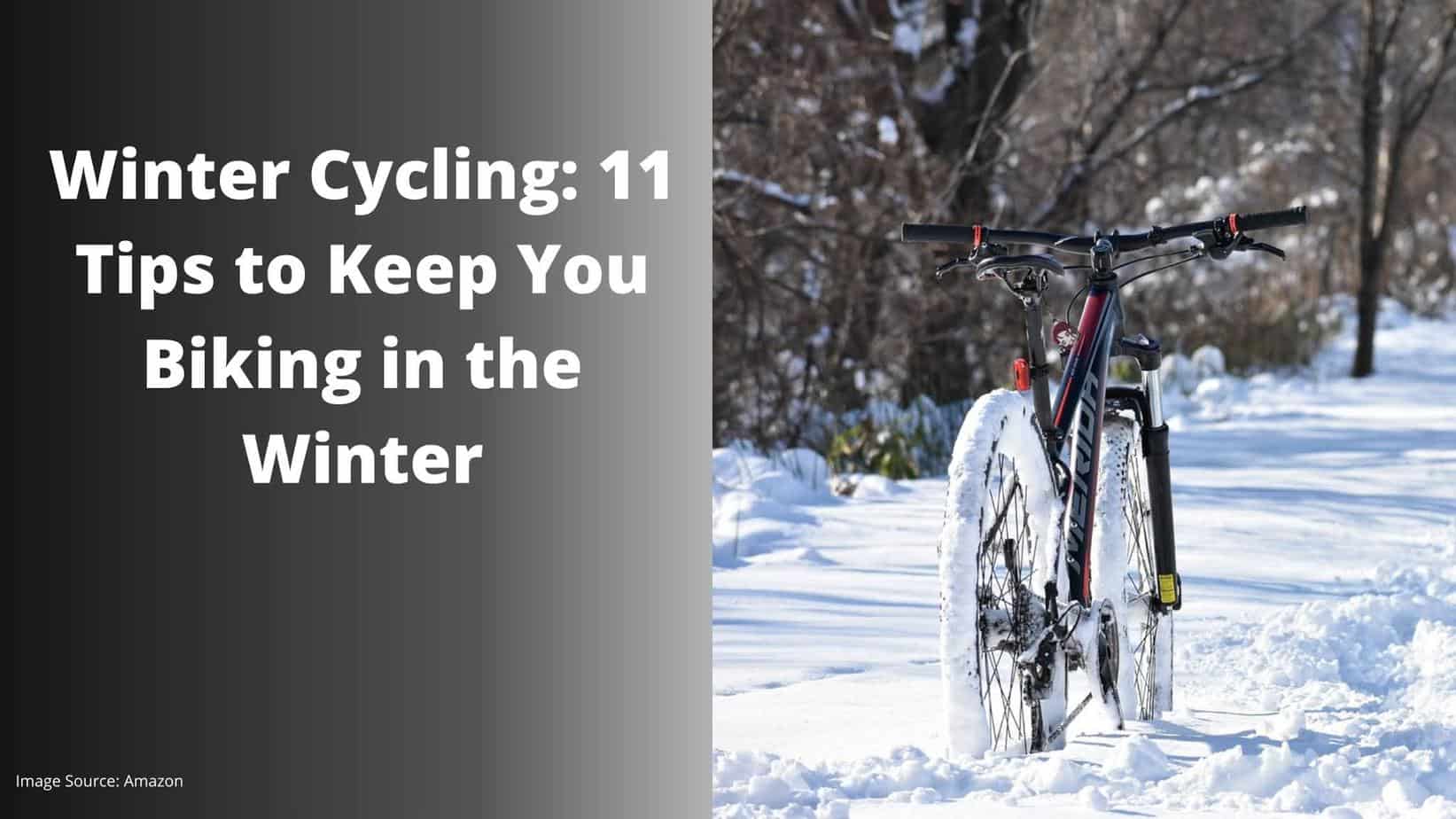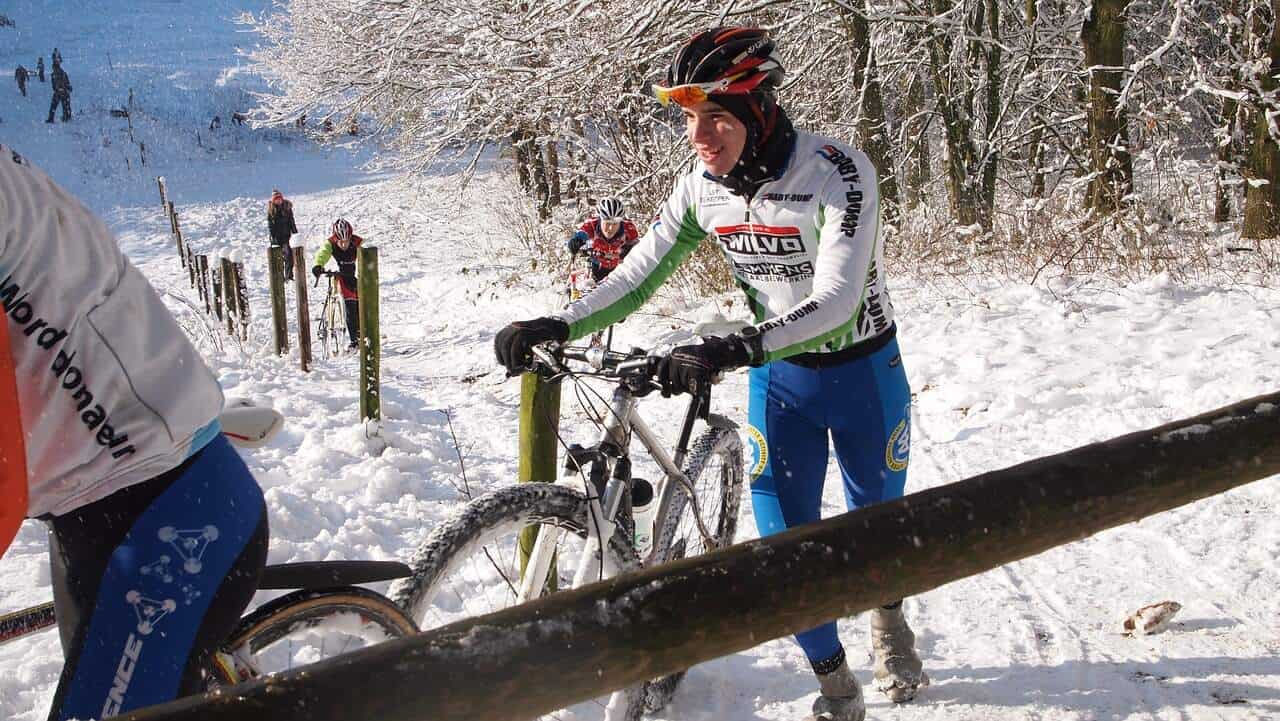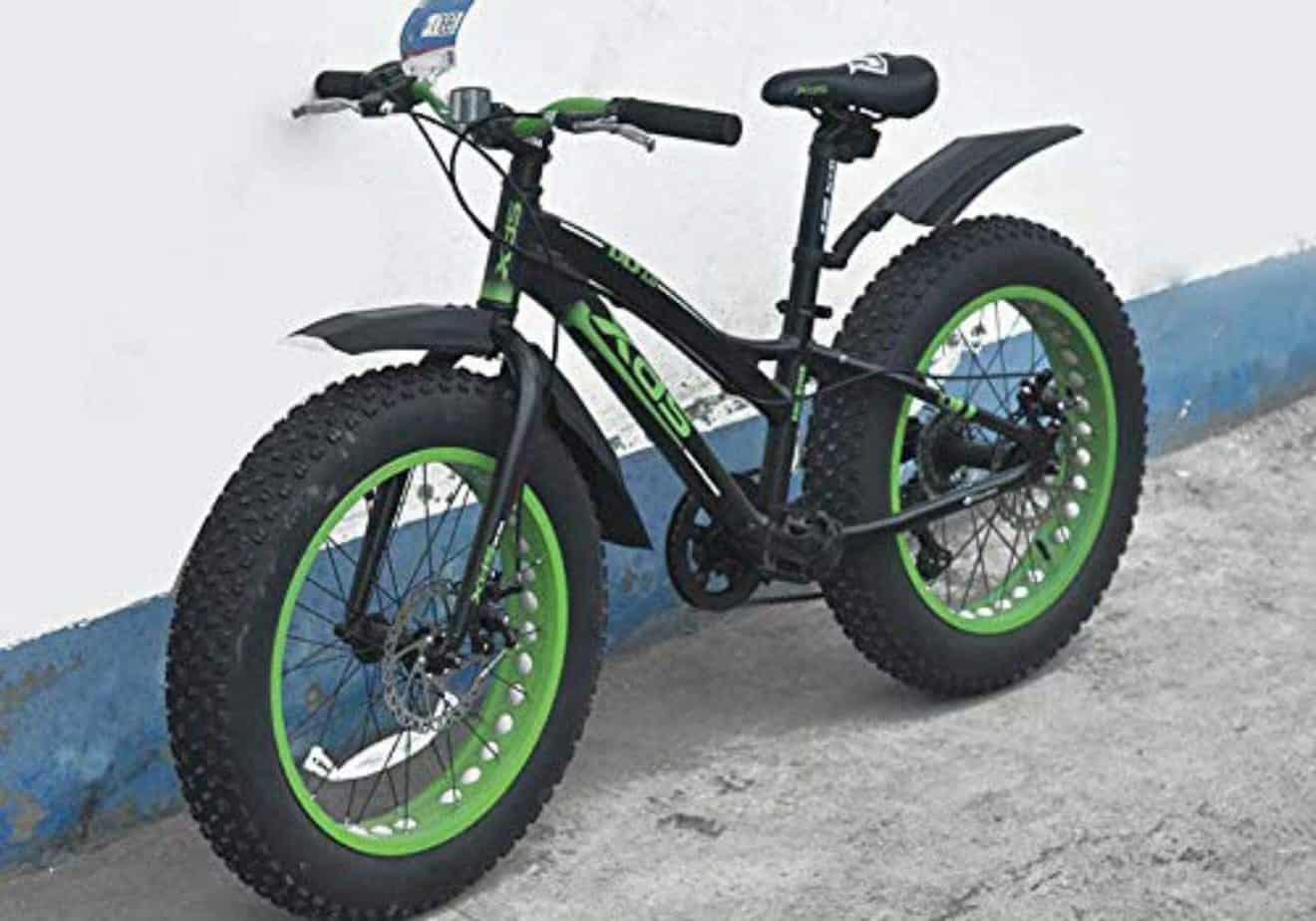Want to enjoy winter cycling? Here are some tips to turn your bike ride this winter into a real adventure.

Image source: Amazon
Overview
People have a love/hate relationship with winter cycling. Cyclist are typically either all-in for continuing to cycle after the fall season or they put their bikes up for 6 months and wait for the warmer days to return.
If you every wondered what keeps people in the saddle, the answer is they are properly equipped to keep warm. It's an easy solution but the equipment required is highly individual and varied as temperatures rise and fall.
Don't let cold weather keep you from one of the best forms of outdoor exercise. Let's get you the gear to counter anything the weather throws at you.
A recent study reveals that your body works hard to get warm in cold conditions, and in that process, you burn more calories and also learn to breathe oxygen more efficiently. Beyond the health benefits, cycling in the winter is cool (pun intended) and fun.
To get you ready for this winter, we have lined up the 11 tips that you should consider before you go out for a ride.
1. Winter Clothing
The most important factor in winter cycling gear is clothing. Always start from the base that feels comfortable against your skin, can bear sweat, and then start adding layers.
The right winter cycling jackets, thermal wear, and other waterproof gears can keep you dry and warm so that you don't notice(experience) cold weather while you ride.

Choose Proper winter clothing to keep you warm throughout the ride.
Image source: Needpix
A complete set of winter clothing can be expensive at the start, however, you need to choose them carefully. Quality definitely matters here.
Many people like to start with a fleece material as the first layer of insulation, but this fabric will also make you sweaty even in extremely cold conditions.
It is best to start with a cotton T-shirt as a base level, and then you add the thicker items as outer layers. A good concept to keep in mind is that the thinnest material should be closest to your skin.
Also, keep the layers as tight as possible. This both helps with wind drag, but more importantly will keep air off your skin.
The best winter cycling gloves and winter cycling shoes will keep you warm throughout the ride.
Tip: If you are not sure of how many layers you should add, then go out and take a small ride and see how it feels.
2. Wash your bike before riding
You need to keep your bike in great condition. Riding in the mud can add dirt to your bike and can cause damage to parts over time.
Especially in winter, you need to take a closer look at chains, gears, cables, and bottom brackets. Wash off regularly, and keep on checking the rims and brakes as these parts get a harsh treatment in cold.
Make sure you clean your bike or at least wipe it out as soon as you finish your ride.
Salty water can ruin cable components and can cause issues with the shifting. Hence, maintaining your bike can reduce mechanical catastrophes.
3. Check tubes and pumps before riding
The worst thing that can happen when riding in cold weather is getting a puncture in the middle of nowhere.
Wet roads can create lubrication of sharp objects and glass that might be not visible and can carcass your tire when your ride.
To make sure this does not happen, have at least 2 tubes and a pump that is working. Be aware of CO2 cartridges, these run out quickly after one or two inflations.
Also, when you operate them in cold weather, the gas can freeze the head of the canister along with your gloves and fingers.
Hence, make sure you have enough spare tubes and pumps.
4. Use Wide Tires
If you have winter tires on your car or truck, you are aware of how useful the increased traction can be in the winter. It's no different for bikes, and having a set of grippy winter tires may make your journey safer, more efficient, and more pleasurable. You'll notice that you're not fishtailing as much, that you're cornering with greater confidence and stability, and that you're absorbing bumps better.
What you should do:
- Determine your tire clearance and determine if you want to run fenders or not, as they will reduce your maximum tire clearance.
- For exceptionally icy/snowy situations, some people may choose to use studded tires, which provide better traction.
Narrow tires tend to rest on the surface beneath the snow, whereas wider tires ride on top of the snow.
Wider tires are less likely to be distracted by an uneven road. Make sure you consider puncture-resistant tires or the ones who have deeper tread when you ride in snow to overcome the chances of riding flat.
Also, racing rubber tires are not the best choice for winter riding. Make sure you opt for tires that have puncture protection and have harder wearing.
Tubeless tires are also a good option, however, these tires are a bit expensive and more complicated to install.
5. Bike Lighting for Your ride
Riding in daylight can be great and easy in winter. You can ride in darkness and still have that bright light in the back and front of your bike.
Visibility is essential when you ride in darker conditions. Make sure you get the brightest light for your bike with a wide viewing angle.
Charging batteries work the best but are a bit expensive. However, a cheap variety of lights work too. Just make sure you keep on changing the batteries so they are bright as new.
6. Use Mudguards
The spray of water, dirt or snow can land directly on your face, bottle, phones, or can soak up your entire clothes or bags in a deeply uncomfortable way. Hence mudguards are very important in winter.

Mudguards keep away water, dirt and snow from flying up and getting all over you
Image source: Amazon
People who ride directly behind and do not have mudguards will definitely know how much water is sprayed by just spinning the tire.
The mudguards don't have to be expensive or extravagant, basic ones can keep you away from the sprays.
7. Carry extra gear
You may never know how cold or worse the temperature can get, make sure you carry an extra pair of gloves with you.
Carrying lightweight gloves can help you to maneuver gears and shifts easily while you ride.
Extra thick pair of woolen socks packed in a bag can help you when your socks are completely soaked due to a puddle.
Cold air can give you a runny nose. Tagging along a handlebar bag is good and can include a cloth to dry your nose. The handlebar bag can also carry tools and excess layers of clothing and a snack and can come in handy when you need to take a break.
8. Hydrate ! Hydrate !Hydrate!
Keep on drinking regularly! It is very easy to forget about water on winter days.

Drink enough water on your winter bike rides
Image source: Piqsels.com
When it comes to winter riding, keeping your bike in good condition is only half the battle. If your hands and feet become numb, you won't be enjoying how smoothly your bike rides. It's equally vital to have the correct gear to keep you safe and comfortable so you can ride all year.
However, you may tend to lose water when you are riding outside in winter. Understand that you have clothing that offers more heat and increase the temperature of your body causing you to sweat.
Even if you don't feel like you are thirsty enough, drink up! You can carry hot beverages or coffee to get warm from the inside.
9. Ride Gingerly on a Slick road
Winter biking can be dicey when you come to a sudden icy road. The riskiest condition is when the ice is just melted out and creates a layer and then freezes creating black ice.
When the roads are in such conditions, always choose indoor cycling options, like bike trainers, or spin bikes.
Riding in the daylight on winter days can also be dangerous when you have black ice, it strikes in your eyes due to the sun. If you have brave slick-roads then ride gingerly.
Slow down in corners and take a wide line and avoid abrupt turns. Use the mountain bike downhill-er trick if you are losing friction while turning.
10. Winter cycling technique
Riding in winter can offer more obstacles like slippery roads, narrowed paths, icy roads, and etc.
When you have geared up and started with your bike, now it's time to understand some basic techniques.
- When you have to ride through a curb: Look out for a pavement or just far from the curb to avoid the dangerous mix of ridges, road, debris, and ice.
- Don't be afraid to take a lane. Your safety is more important than preference. For any reason, you are not able to take a lane, then choose the less snowy path and ride slower.
- Limit any sudden turns or unusual movement and use hand gestures while turning or changing lanes.
- Keep yourself relaxed with loose legs and elbow position. This will help you absorb movements while you run over ice ridges or any other dangerous areas.
- Avoid areas with melted snow. The black ice is the most dangerous condition for you to ride a bike. Ride slow and steady through this surface. Take a fall if your tires slip.
- You get to avoid icy roads and debris in milder areas. However, riding technique remains the same: ride loosely and stay alert, watch out for danger that can cause damage to your wheels and body.
- Make yourself visible with bike lights and reflective clothing.
- The more exposed parts you have on your bike, the more salt and dirt it can hold and affect your riding experience. Get your chains cleaned up every time. Re Grease your chain lube for dirty climates.
- Keep cleaning your bike after every ride.
11. Don't ignore your skin
Even if it's winter you should never forget to apply sunscreen on your exposed body parts. Snow reflects up to 90% of UV radiation even on winter days and can cause damage to your skin.
Your face can dry out and get frigid during winter. Using a good UV reflecting lotion, moisturizer, or vaseline can help you protect your exposed skin and maintain moisture.
Also do not forget your lip balm.
Conclusion
Bike riding is an enjoyable activity for both novice and expert riders. It has many benefits, including fitness, weight loss, and mental health. It is advisable to practice safe winter cycling techniques to keep you safe from accidents and injuries.
It’s a fact that winters bring about many challenges for us. But we can overcome all these by keeping our minds prepared and being careful. We must keep ourselves fit and healthy as well. So, let’s start enjoying the season!
